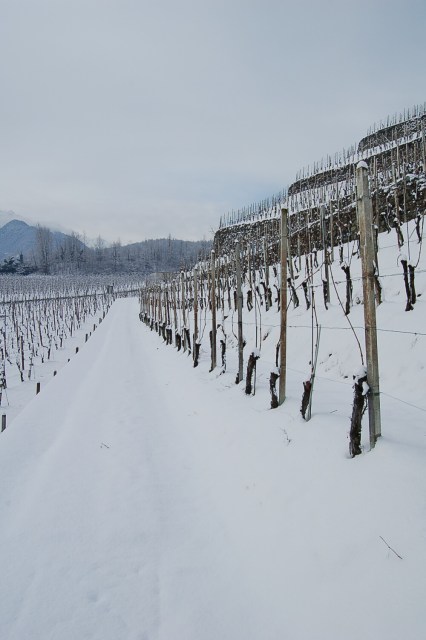2019 Casa Vinicola Triacca ‘Gaux Dopo’ Nebbiolo
This Alpine Nebbiolo is energetic, zippy, and remarkably fresh. The stainless steel fermentation maintains the wine’s bright fruit character, floral quality, and natural suppleness.
Sustainable farming practices and only 100 cases produced!
Pairs with
The “La Gatta” estate was originally built in the 1500s as a Dominican monastery and was later purchased as a summer home for the aristocratic de Gatti family, from which the name derives. The Triacca family acquired the old monastery in 1969, which is surrounded by 13 hectares of vigorous vines grown on the steep hillsides of the Italian Alps. In 1987, Domenico Triacca acquired 2,000 square meters of vineyards in Valgella, one of the most highly sought after vineyard areas in Valtellina and built himself a small cellar to start producing and aging wines from his own vineyards. Today, Lucca Triacca runs the estate and is known as one of the most innovative Valtellina producers.
Valtellina lies in an Alpine valley in the northern part of the country in the Lombardy region. It actually forms part of the border between Italy and Switzerland and historically has been Swiss and Austrian territory before becoming part of Italy in 1859. The area benefits from a cool, mountain climate, though ‘La Breva,’ a gentle wind that originates over Lake Como, moves warm air into the valley and helps promote pollination in the spring. The vineyards lie on extremely steep slopes and tiny terraces (similar to the Mosel or Alto Adige) requiring it all to be worked by hand. Some suggest that Nebbiolo may have even originated in Valtellina! Today, it is known for its bright, cherry-scented Nebbiolo, known here as Chiavennasca (after the nearby town of Chiavenna).
“Nebbiolo from Valtellina has always been one of my favorite expressions of this grape. It’s Alpine wine; a much lighter and fresher version of your typical Nebbiolo from Piedmont that you might be more familiar with. They are high acid, food-friendly wines that are often significantly more affordable than your average Barolo. These wines are great with good company, a cheese & charcuterie plate, and some light pasta.” – Lexi Jones, Director of Imports
Related Items
-
Best Seller
2022 Wonderland Project Atlas Peak Cabernet Sauvignon
$55.00Grown high on a west-facing slope above the fog line on the northern ridge of Atlas Peak, this is a true mountain Cabernet. The palate is dense, layered, and impeccably structured, finishing long and refined. It carries the essence of red volcanic soil, wild California chaparral, and sun-drenched hillsides. All we can say is, there’s a reason the The French Laundry picked this gem up.
Organic farming practices, native yeast fermentation, unfined/unfiltered, vegan-friendly and only 1,100 cases produced.
-
Liquore delle Sirene Aperitivo Americano Rosso
$40.00This aperitivo is made from organically-farmed Trebbiano di Soave and Garganega grapes, as well as local herbs from Lake Garda, Italy. No chemicals or artificial coloring are used.
This is an aperitivo (think Aperol) but unlike Aperol, is not an industrial, mass produced product.
HOW TO DRINK IT
Enjoy on the rocks, in a Spritz, negroni, or in a paloma with your favorite tequila or mezcal. -
2018 Gonzague & Claire Lurton ‘Acaibo’ Chalk Hill Cabernet Sauvignon
$95.00Crafted by Bordeaux’s renowned Lurton family in Sonoma’s Chalk Hill AVA, Acaibo embodies the harmony of Old World elegance and New World power. This limited-production Cabernet blend is an expressive, age-worthy wine that was made for the table. Pair it with herb-crusted lamb chops, grilled ribeye, or braised short ribs over creamy polenta.
Organic farming practices and aged for 16 months in French oak barrels (65% new).
-
2023 Domaine Chancelle Saumur Champigny Cabernet Franc
$30.00This wine was voted Best of Club Argaux by members. Not a member? Sign up for CLUB ARGAUX receive 15% OFF all club wines.
Reminiscing on that delicious carafe of bistro wine from your last jaunt to Paris? There’s a good chance that it was made from Cabernet Franc. These peppery, earthy wines are perfect for enjoying with a slight chill and with a variety of hearty fare like pot roast or rack of lamb.
Sustainable farming practices, 40-year-old vines, hand harvested, and vinified in a combination of tank and used oak foudres. Light filtration prior to release.










